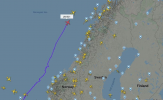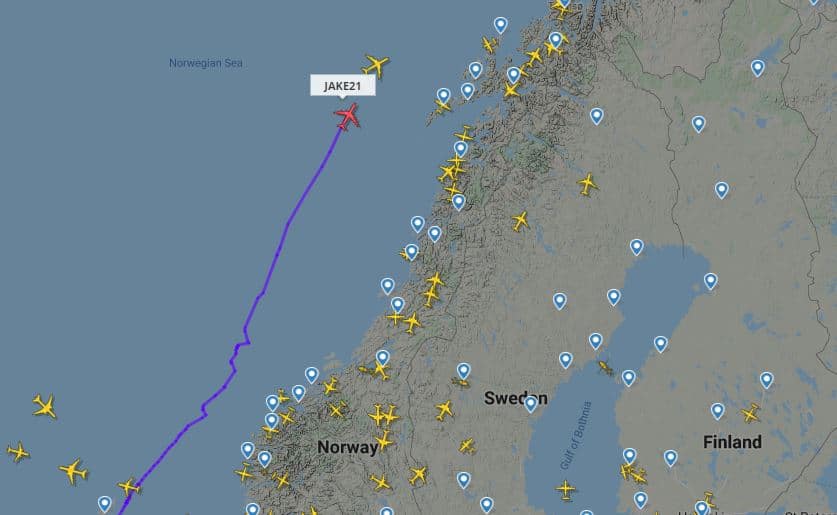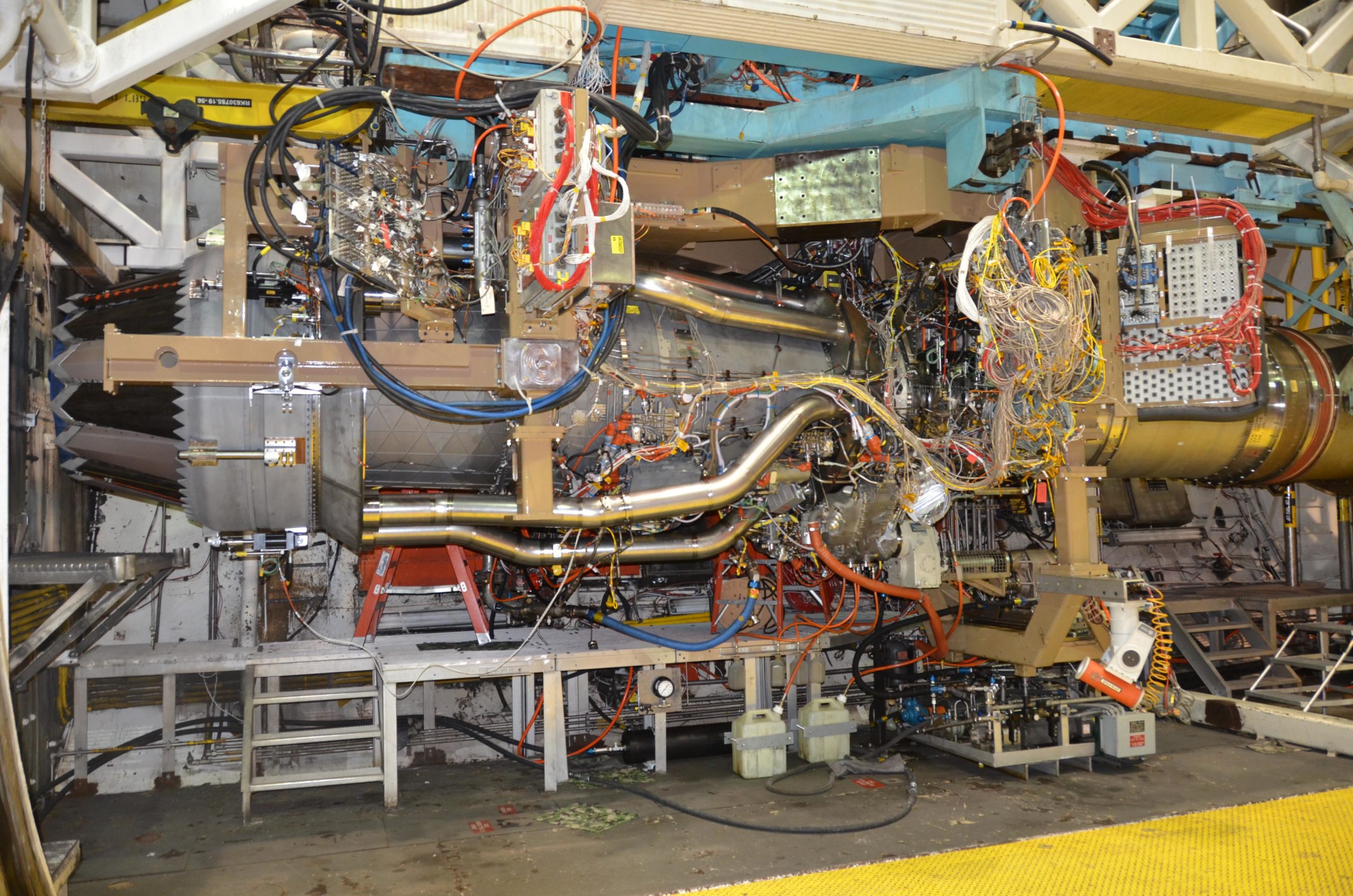Ei AMRAAM välttämättä etäisyytietoa tarvitse, jos sen laukaisee "Maddogina". Silloin se vaan hakeutuu ensimmäiseen maaliin, mikä sattuu eksymään sen hakukeilaan. Lentoprofiili on vain tällöin suora, eikä kovin tehokas.Ohjukselle pitää saada etäisyystieto jollakin tavalla ja IRST sitä ei kykene yksin tuottamaan. On aivan sama että saadaanko etäisyystieto ulkoiselta sensorilta, omalta tutkalta tai laserilta. Vaikka etäisyys tunnettaisiin tarkkaan, tutkalla ohjaaminen ei mahdollista siis täysin passiivista laukaisua sekään, koska tutkasäteily voidaan havaita. Tuo lööppi osoittaa taas sen että pelkkä otsikko antaa asiasta usein hieman harhaanjohtavan kuvan, kun tekstissä asia tarkentuu. Vähän sama kuin lukee iltapäivälehtien raflaavia otsikoita vs. teksti jossa asia muuttuu vähemmän mustavalkoiseksi.
On syynsä miksi esimerkiksi Rafalen FSO:a on laseretäisyysmittari. Samaten maalinosoituspodeissa on pääasiassa laseretäisyysmittari ja lisäksi joskus lasermaalinosoitin. Pelkkä kulmanopeuden mittaaminen passiivisesti ei ole sama asia kuin suoran etäisyystiedon mittaaminen maaliin. Jotenkin pitää saada tietää että mille etäisyydelle ohjus voidaan laukaista että se tavoittaa maalin ja lentorata osataan laskea optimaallisesti torjunnan onnistumiseksi. Mikään keskimatkan torjunta ei onnistu jos etäisyystietoa ja maalin korkeutta sekä nopeutta ei tiedetä tarkasti. Varsinkin kun puhutaan hävittäjämaalista.
AMRAAM hyökkää pääasiassa yläkautta sirpalekuvion takia sekä maksimoimalla liike-energiansa loppulähestymisessä (kun ei ole RAMJET). Sen perusteella on tärkeä tietää mille lentoradalle ohjus saadaan että sillä olisi mahdollisuuksia osua nopeasti liikkuvaan ja liikehtivään maaliin. Kulmareittiohjaus vaatii myös liikeparametrien tietämistä ennen laukaisua että ennakkopiste osataan laskea oikein. Lisäksi sitä pitää päivittää.
Lähietäisyydellä tapahtuva LOBL/LOAL ammunta ir-ohjuksella on eri asia, kun ohjuksen kuvapäällä tai kypärätähtäimellä / tutkalla saadaan maalitieto tai suora lukitus ja ollaan alle 20 km etäisyydellä.
Install the app
How to install the app on iOS
Follow along with the video below to see how to install our site as a web app on your home screen.
Note: This feature may not be available in some browsers.
You are using an out of date browser. It may not display this or other websites correctly.
You should upgrade or use an alternative browser.
You should upgrade or use an alternative browser.
Ilmavoimien tulevaisuus
- Viestiketjun aloittaja Museo
- Aloitus PVM
-
- Tagit
- ilmavoimat tulevaisuus
Einomies1
Respected Leader
Puhuttiin keskimatkan torjunnasta, ei alle 10 km lähitaistelusta jossa ohjuksen oma TDD kykenee lukittumaan suoraan. Pidemmälle ei varmasti kyetä osumaan. Vaikka pystyisi laukaisuun niin ei ole mitään mieltä vartailla ohjusta raketteihin.Ei AMRAAM välttämättä etäisyytietoa tarvitse, jos sen laukaisee "Maddogina". Silloin se vaan hakeutuu ensimmäiseen maaliin, mikä sattuu eksymään sen hakukeilaan. Lentoprofiili on vain tällöin suora, eikä kovin tehokas.
Onko Maddog aina laukaistava Pitbull-etäisyydeltä, että se saisi piikin heti raiteelta lähtiessä, vai voiko se lentää suoraan niin kauan kuin löytää jotain, mihin hakeutua?Puhuttiin keskimatkan torjunnasta, ei alle 10 km lähitaistelusta jossa ohjuksen oma TDD kykenee lukittumaan suoraan. Pidemmälle ei varmasti kyetä osumaan. Vaikka pystyisi laukaisuun niin ei ole mitään mieltä vartailla ohjusta raketteihin.
Armchair pilot
Kapteeni
Ei tarvi lukittua suoraan kiskoilta. Yleisesti vältetään ampumasta ilman validia maalitietoa, koska se voi sitten lukittua ihan mihin tahansa minkä sattuu löytämään ja voi tosiaan paskalla tuurilla (tai hyvällä) lentää sen 100+ kilsaa. Keneen nalli napsahtaa jne.Onko Maddog aina laukaistava Pitbull-etäisyydeltä, että se saisi piikin heti raiteelta lähtiessä, vai voiko se lentää suoraan niin kauan kuin löytää jotain, mihin hakeutua?
Olympiakasarmi
Kenraali
Tietävätköhän tiedemiehet ja insinöörit jotain mitä me emme tiedä?

 www.militaryaerospace.com
www.militaryaerospace.com

Boeing and Lockheed Martin to build stealthy infrared search and track (IRST) avionics for F-15C jet fighter
WRIGHT-PATTERSON AFB, Ohio – U.S. Air Force air combat experts are asking electro-optics engineers at the Boeing Co. and Lockheed Martin Corp. to design and build six additional...
WRIGHT-PATTERSON AFB, Ohio – U.S. Air Force air combat experts are asking electro-optics engineers at the Boeing Co. and Lockheed Martin Corp. to design and build six additional infrared search and track (IRST) sensors for the F-15C Eagle jet fighter to enable the aircraft to detect, track, and attack enemy aircraft in a stealthy way without making its presence known.
Officials of the Air Force Life Cycle Management Center at Wright-Patterson Air Force Base, Ohio, announced a potential $40 million order Monday to the Boeing Co. Defense, Space & Security segment in St. Louis to integrate six IRST Block II systems for The single-seat F-15C jet fighter.
The F-15C's IRST is a long-wave infrared detection system that targets aircraft in a radar-denied environment. The system, which Boeing is buying from the Lockheed Martin Missiles and Fire Control segment in Orlando, Fla., uses infrared search and track technology to detect and provide weapon-quality track solutions on potentially hostile aircraft.
For the F-15C, Lockheed Martin is providing the company's Legion Pod sensor system, which consists of a passive longwave infrared receiver, a processor, inertial measurement unit, and environmental control unit. The infrared receiver, processor, and inertial measurement unit fit inside the sensor pod, which attaches to a weapons station underneath the aircraft.
Huhta
Greatest Leader
Minä en yhtään ihmettelisi, vaikka IRST kykenisi tuottamaan ihan laadukasta etäisyystietoa. Niillähän saadaan tänä päivänä esiin paljon muutakin kuin pelkkä lämpöjälki, voidaan hyvin tunnistaa kohde konetyypin tarkkuudella. Kun tiedetään, minkäkokoista kohdetta katsotaan, niin stadiametrisellä etäisyysmittauksella saadaan hyvä arvio maalin etäisyydestä.
Olympiakasarmi
Kenraali
Löytyi tällainen tieto.Minä en yhtään ihmettelisi, vaikka IRST kykenisi tuottamaan ihan laadukasta etäisyystietoa. Niillähän saadaan tänä päivänä esiin paljon muutakin kuin pelkkä lämpöjälki, voidaan hyvin tunnistaa kohde konetyypin tarkkuudella. Kun tiedetään, minkäkokoista kohdetta katsotaan, niin stadiametrisellä etäisyysmittauksella saadaan hyvä arvio maalin etäisyydestä.
On the other hand, they do not measure range directly, as radars do. However, modern IRST systems employ indirect methods for range measurement, featuring passive ranging.
John Hilly
Respected Leader
Ehkä väärä ketju, mutta...

Kasperi Summanen | 11.08.2021 | 23:57
Säteilyvalvontakoneen lentojen tarkoituksesta ei ole tietoa.
Yhdysvaltain ilmavoimien ainoa käytössä oleva WC-135W-tiedustelukone on noussut jälleen ilmaan ja lentänyt Britanniasta Norjan rannikkoa pitkin kauas pohjoiseen aina Barentsinmerelle asti.
Myös Constant Phoenix -nimellä tunnetun koneen lento on mielenkiintoinen. Säteilyhavaintojen tekemiseen erikoistunut kone on täällä päin erittäin harvinainen vieras. Tunnusta JAKE21-käyttäneen koneen noin 12 tunnin mittaisen lennon tarkoituksesta ei ole tietoa.
Constant Phoenixin tiedetään saapuneen Britannin Mildenhallin lentotukikohtaan heinäkuussa. Se nousi sieltä taivaalle ensi kertaa viime viikon torstaina. Tuolloin Constant Phoenix lensi niin ikään erikoisen tehtävän Itämerellä.
Siellä se kiersi edestakaista reittiä meren yllä Kaliningradin edustalta Viron Saaremaan kohdalle ulottuvalla alueella. Kone lensi merellä välillä vain reilun puolentoista kilometrin korkeudessa. Verkkouutiset kertoi lennosta tässä.
Constant Phoenixin aiempi Itämeren lento on huomioitu amerikkalaismediassakin. Puolustusasioihin ja ilmailuun erikoistuneen The DrivenWar Zone -sivuston mukaan ”oudon lennon” tarkoituksena saattoi olla kauempaa idästä tai pohjoisesta tulleiden radioaktiivisten hiukkasten haistelu. Ne taas voisivat kytkeytyä venäläisiin asekokeisiin.
Venäjän tiedetään testanneen ydinkäyttöistä Burevestnik-risteilyohjustaan pohjoisessa vaihtelevalla menestyksellä. Yhden epäonnistuneen kokeen uskotaan olleen kaksi vuotta sitten sattuneen säteilyonnettomuuden takana.

 www.verkkouutiset.fi
www.verkkouutiset.fi

Harvinainen USA:n tiedustelukone kiersi nyt Pohjolaa
Kasperi Summanen | 11.08.2021 | 23:57
Säteilyvalvontakoneen lentojen tarkoituksesta ei ole tietoa.
Yhdysvaltain ilmavoimien ainoa käytössä oleva WC-135W-tiedustelukone on noussut jälleen ilmaan ja lentänyt Britanniasta Norjan rannikkoa pitkin kauas pohjoiseen aina Barentsinmerelle asti.
Myös Constant Phoenix -nimellä tunnetun koneen lento on mielenkiintoinen. Säteilyhavaintojen tekemiseen erikoistunut kone on täällä päin erittäin harvinainen vieras. Tunnusta JAKE21-käyttäneen koneen noin 12 tunnin mittaisen lennon tarkoituksesta ei ole tietoa.
Constant Phoenixin tiedetään saapuneen Britannin Mildenhallin lentotukikohtaan heinäkuussa. Se nousi sieltä taivaalle ensi kertaa viime viikon torstaina. Tuolloin Constant Phoenix lensi niin ikään erikoisen tehtävän Itämerellä.
Siellä se kiersi edestakaista reittiä meren yllä Kaliningradin edustalta Viron Saaremaan kohdalle ulottuvalla alueella. Kone lensi merellä välillä vain reilun puolentoista kilometrin korkeudessa. Verkkouutiset kertoi lennosta tässä.
Constant Phoenixin aiempi Itämeren lento on huomioitu amerikkalaismediassakin. Puolustusasioihin ja ilmailuun erikoistuneen The DrivenWar Zone -sivuston mukaan ”oudon lennon” tarkoituksena saattoi olla kauempaa idästä tai pohjoisesta tulleiden radioaktiivisten hiukkasten haistelu. Ne taas voisivat kytkeytyä venäläisiin asekokeisiin.
Venäjän tiedetään testanneen ydinkäyttöistä Burevestnik-risteilyohjustaan pohjoisessa vaihtelevalla menestyksellä. Yhden epäonnistuneen kokeen uskotaan olleen kaksi vuotta sitten sattuneen säteilyonnettomuuden takana.
USAF WC-135W 61-2667 returning to RAF Mildenhall, UK after ~12 hours in flight.https://t.co/N4S5ErRjZ0#ADSB #AE0941 pic.twitter.com/t4tC1QcFZW
— Amelia (@ameliairheart) August 9, 2021

Harvinainen USA:n tiedustelukone kiersi nyt Pohjolaa | Verkkouutiset
Harvinainen USA:n tiedustelukone kiersi nyt Pohjolaa | Verkkouutiset
 www.verkkouutiset.fi
www.verkkouutiset.fi
Samanlaista haistelua tekivät Itämerellä heti sen jälkeen kun Venäjän ydinsukellusvene sippasi Tanskan rannikolle. Sehän lähti Norjan rannikkoa pitkin jatkamaan matkaansa. Todennäköisesti epäilevät toksista vuotoa ja Bornholmissa oli maamittausaseman mittarit värähtäneetkin.
Jossain ketjussa täällä oli enemmänkin pohdintaa aiheesta.
Jossain ketjussa täällä oli enemmänkin pohdintaa aiheesta.
Ehkä väärä ketju, mutta...
Katso liite: 52141
Harvinainen USA:n tiedustelukone kiersi nyt Pohjolaa
Kasperi Summanen | 11.08.2021 | 23:57
Säteilyvalvontakoneen lentojen tarkoituksesta ei ole tietoa.
Yhdysvaltain ilmavoimien ainoa käytössä oleva WC-135W-tiedustelukone on noussut jälleen ilmaan ja lentänyt Britanniasta Norjan rannikkoa pitkin kauas pohjoiseen aina Barentsinmerelle asti.
Myös Constant Phoenix -nimellä tunnetun koneen lento on mielenkiintoinen. Säteilyhavaintojen tekemiseen erikoistunut kone on täällä päin erittäin harvinainen vieras. Tunnusta JAKE21-käyttäneen koneen noin 12 tunnin mittaisen lennon tarkoituksesta ei ole tietoa.
Constant Phoenixin tiedetään saapuneen Britannin Mildenhallin lentotukikohtaan heinäkuussa. Se nousi sieltä taivaalle ensi kertaa viime viikon torstaina. Tuolloin Constant Phoenix lensi niin ikään erikoisen tehtävän Itämerellä.
Siellä se kiersi edestakaista reittiä meren yllä Kaliningradin edustalta Viron Saaremaan kohdalle ulottuvalla alueella. Kone lensi merellä välillä vain reilun puolentoista kilometrin korkeudessa. Verkkouutiset kertoi lennosta tässä.
Constant Phoenixin aiempi Itämeren lento on huomioitu amerikkalaismediassakin. Puolustusasioihin ja ilmailuun erikoistuneen The DrivenWar Zone -sivuston mukaan ”oudon lennon” tarkoituksena saattoi olla kauempaa idästä tai pohjoisesta tulleiden radioaktiivisten hiukkasten haistelu. Ne taas voisivat kytkeytyä venäläisiin asekokeisiin.
Venäjän tiedetään testanneen ydinkäyttöistä Burevestnik-risteilyohjustaan pohjoisessa vaihtelevalla menestyksellä. Yhden epäonnistuneen kokeen uskotaan olleen kaksi vuotta sitten sattuneen säteilyonnettomuuden takana.

Harvinainen USA:n tiedustelukone kiersi nyt Pohjolaa | Verkkouutiset
Harvinainen USA:n tiedustelukone kiersi nyt Pohjolaa | Verkkouutisetwww.verkkouutiset.fi
rty19
Greatest Leader

U.S. Air Force to test ‘Quarterhorse’ autonomous Mach 5 jet
Hermeus has signed a $60 million U.S. Air Force partnership for the flight testing of its first Mach 5 aircraft – 'Quarterhorse'.
 ukdefencejournal.org.uk
ukdefencejournal.org.uk
USAF: New Engine Technologies Can’t Be Retrofitted to Existing Fighters
12 Aug 2021 John A. Tirpak
"New engine technologies emerging from the Adaptive Engine Transition Program are “vastly different” from those now flying on Air Force fighters, so retrofitting the current force with the new power plants won’t be possible, the service’s program executive officer for fighters and advanced aircraft said Aug. 12.
The AETP technologies “really are future looking” and not applicable to existing fighters, Brig. Gen. Dale R. White told reporters in a press conference associated with the Air Force Life Cycle Management Center’s recent Life Cycle Industry Days symposium. The AETP, based on previous advanced engine programs, got underway in 2016, and full-scale engine tests have been conducted this year. General Electric’s version is the XA-100, while Pratt & Whitney’s is the XA-101. The AETP is developing power plants using third-stream airflow to combine fuel-sipping benefits during cruise with quick-reaction high thrust, as needed in fighter engagements....
...the technologies in AETP are “very different than what we use on the fielded systems that we have,” he said. Where there are opportunities to make them “backward compatible,” that will be done, but White suggested there have been few such instances. Changing the propulsion system on a fielded aircraft is “extremely complex, and there’s a lot that goes with that,” White said. “So you have to think about what the return on investment might be, there.”...
...Air Force and Pentagon leaders have hinted that future versions of the F-35 fighter could use new engines developed under AETP to save on fuel and gain performance. Even newly minted Air Force Secretary Frank Kendall suggested as much in his first interview with Air Force Magazine.
But White’s comments indicate that while the F-35’s F135 engine can be improved, it won’t be replaced by whatever emerges from AETP. Senior Air Force leaders have said in testimony this spring that wholesale replacement of engines already in service is not affordable within anticipated budgets.
Pratt & Whitney, maker of the F135, proposed a package of improvements for the engine to the Joint Program Office in March, which the JPO is evaluating."

USAF: New Engine Technologies May Not Retrofit to Existing Fighters | Air & Space Forces Magazine
Existing USAF fighters won't be able to be retrofitted with new engines being developed by the Adaptive Engine Transition Program, officials say.
Olympiakasarmi
Kenraali
Eiköhän KC-46:n ongelmat saada kohtapuolin ratkaistua. Yritys on ainakin kova.

 www.defensenews.com
www.defensenews.com

The KC-46 has a messy problem with its palletized toilet
The head of U.S. Transportation Command says the issue won't affect plans to conduct limited operations with the KC-46 this summer.
Tuossa kun oli juttua Irlannin mahdollisesta hävittäjähankkeesta (mikä taas in ison jos sanan takana), ja siellä oli mainintana, että heillä toimintamenot hävittäjälaivueelle olisi 50-100 miljoonaa euroa vuodessa, niin Suomen tehokkuudella (250 milj. e ~65 koneelle), heidän vuosittainen rahoitus riittäisi noin tusinalle - parille tusinalle hävittäjiä.
HotShot
Kapteeni
Irlannin ilmavoimilla ei ole ollut hävittäjiä toisen maailmansodan jälkeen, ja eipä heillä ole ollut niihin tarvetta. Vaikka kyseessä on saarivaltio niin heidän laivastossakaan ei ole kuin vartiolaivoja. Tällä hetkellä heillä on ainoastaan pieni määrä rynnäköintiin kykeneviä Pilatus PC-9 potkurikoneita ja Brittien RAF hoitaa tarvittavat tunnistuslennot Irlannin ilmatilassa. Tämän hetkiset puheet tarkoittavat yhden laivueen varustamista tunnistuslentoihin kykenevillä hävittäjillä joten nuo toimintamenot riittää varmaan hyvin.Tuossa kun oli juttua Irlannin mahdollisesta hävittäjähankkeesta (mikä taas in ison jos sanan takana), ja siellä oli mainintana, että heillä toimintamenot hävittäjälaivueelle olisi 50-100 miljoonaa euroa vuodessa, niin Suomen tehokkuudella (250 milj. e ~65 koneelle), heidän vuosittainen rahoitus riittäisi noin tusinalle - parille tusinalle hävittäjiä.
Olympiakasarmi
Kenraali
Voi olla, että Iso-Britannia on hienovaraisesti vihjannut Irlannille hävittäjälaivueen tarpeesta Irlannin länsipuolelle suuntautuville tunnistuslennoille. Luin jostain brittien kommenttia siitä miten kauan kestää lentää Englannista paikalle ja kuinka paljon tankkauslentoja tarvitaan tueksi.Irlannin ilmavoimilla ei ole ollut hävittäjiä toisen maailmansodan jälkeen, ja eipä heillä ole ollut niihin tarvetta. Vaikka kyseessä on saarivaltio niin heidän laivastossakaan ei ole kuin vartiolaivoja. Tällä hetkellä heillä on ainoastaan pieni määrä rynnäköintiin kykeneviä Pilatus PC-9 potkurikoneita ja Brittien RAF hoitaa tarvittavat tunnistuslennot Irlannin ilmatilassa. Tämän hetkiset puheet tarkoittavat yhden laivueen varustamista tunnistuslentoihin kykenevillä hävittäjillä joten nuo toimintamenot riittää varmaan hyvin.
Olympiakasarmi
Kenraali
USA ja Kanada aikovat yhdessä uudistaa NORADin toiminnot sensoreilla joita sijoitetaan kaikkialle veden alta avaruuteen ja modernisoimalla taistelunjohtojärjestelmät. Onkohan jossakin "salaisessa lisäpöytäkirjassa" maininta, että Kanada hankkii hävittäjät USA:sta?

 www.c4isrnet.com
www.c4isrnet.com

US and Canada want to collaborate on NORAD modernization
In a joint statement, the nations pledged to upgrade NORAD's sensors and modernize the data infrastructure needed to detect more threats faster.
rty19
Greatest Leader
USA ja Kanada aikovat yhdessä uudistaa NORADin toiminnot sensoreilla joita sijoitetaan kaikkialle veden alta avaruuteen ja modernisoimalla taistelunjohtojärjestelmät. Onkohan jossakin "salaisessa lisäpöytäkirjassa" maininta, että Kanada hankkii hävittäjät USA:sta?
Mistä muualta ne koneet voi hankkia kun Norad-asioista muut maat ei paljon tiedä?
Olympiakasarmi
Kenraali
Periaatteessa konekaupan voisi jakaa kahteen, NORAD ja NATO-koneet, mutta se ei ole kovinkaan kustannustehokasta Kanadan tapauksessa. Ennen Horneteja siellähän oli 3 konetyyppiä tehtävän mukaa. Ilmapuolustuksessa 3 laivuetta CF-101 koneita, Länsi-Saksassa 3 laivuetta CF-104 koneita ja kotimaassa varalla 2 laivuetta CF-5 koneita erityisesti NATO:n Pohjoisen sivustan (Norja) operaatioihin.Mistä muualta ne koneet voi hankkia kun Norad-asioista muut maat ei paljon tiedä?
rty19
Greatest Leader
Nyt maailman tilanne on toinen joten tuskin Saksassa tarvii olla 3 laivuetta kylmänsodan skenaarioiden varalta.Periaatteessa konekaupan voisi jakaa kahteen, NORAD ja NATO-koneet, mutta se ei ole kovinkaan kustannustehokasta Kanadan tapauksessa. Ennen Horneteja siellähän oli 3 konetyyppiä tehtävän mukaa. Ilmapuolustuksessa 3 laivuetta CF-101 koneita, Länsi-Saksassa 3 laivuetta CF-104 koneita ja kotimaassa varalla 2 laivuetta CF-5 koneita erityisesti NATO:n Pohjoisen sivustan (Norja) operaatioihin.
Kanada on suuri maa joten ainakin pitkä toimintasäde olisi hyvä ominaisuus. Miten mahtaa Gripenillä riittää? +Norad haasteet päälle.
Muutenhan koneet ostetaan jenkkilästä.
Viimeksi muokattu:
